Sustainable Hospitality Report: Green Hotel Case Study
VerifiedAdded on 2021/05/30
|25
|4708
|86
Report
AI Summary
This report provides a comprehensive analysis of sustainable hospitality, specifically examining the case of a green hotel or eco-lodge situated in a coastal, rural community. The report delves into various aspects of environmental management systems, including legal and competitive considerations, and outlines a phased approach to implementation. It explores sustainable goals encompassing socio-cultural and economic performance, data assessment through SWOT analysis, employee training, and management system documentation. The report also examines standard criteria related to social, economic, cultural heritage, and environmental sustainability, including sustainable design, purchasing policies, energy and water management, and waste management plans. Furthermore, it presents a detailed marketing strategy tailored to the eco-lodge's target market, covering positioning, product/service policies, and promotional channels. The report concludes with a summary of key findings and recommendations for sustainable operation.
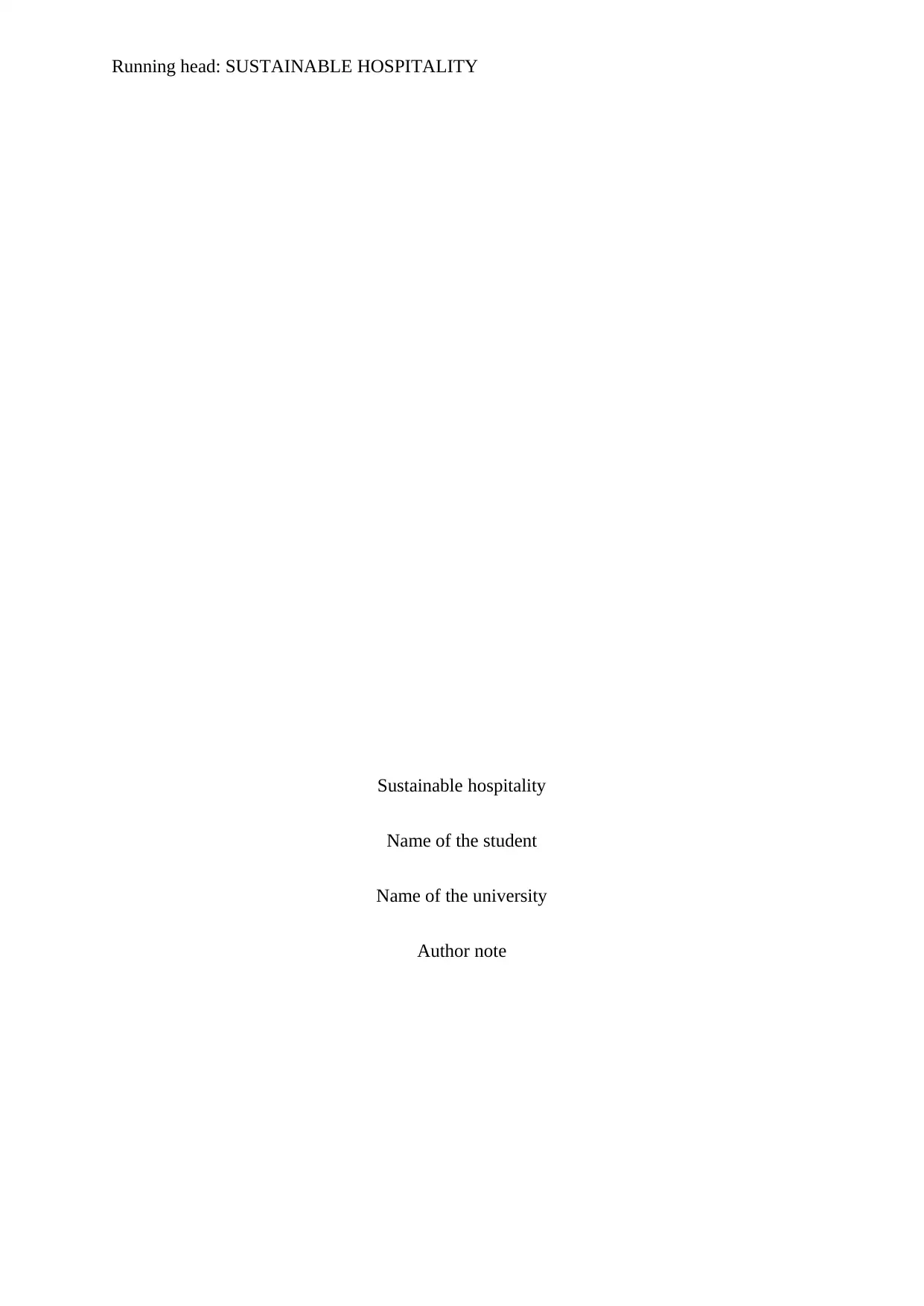
Running head: SUSTAINABLE HOSPITALITY
Sustainable hospitality
Name of the student
Name of the university
Author note
Sustainable hospitality
Name of the student
Name of the university
Author note
Paraphrase This Document
Need a fresh take? Get an instant paraphrase of this document with our AI Paraphraser
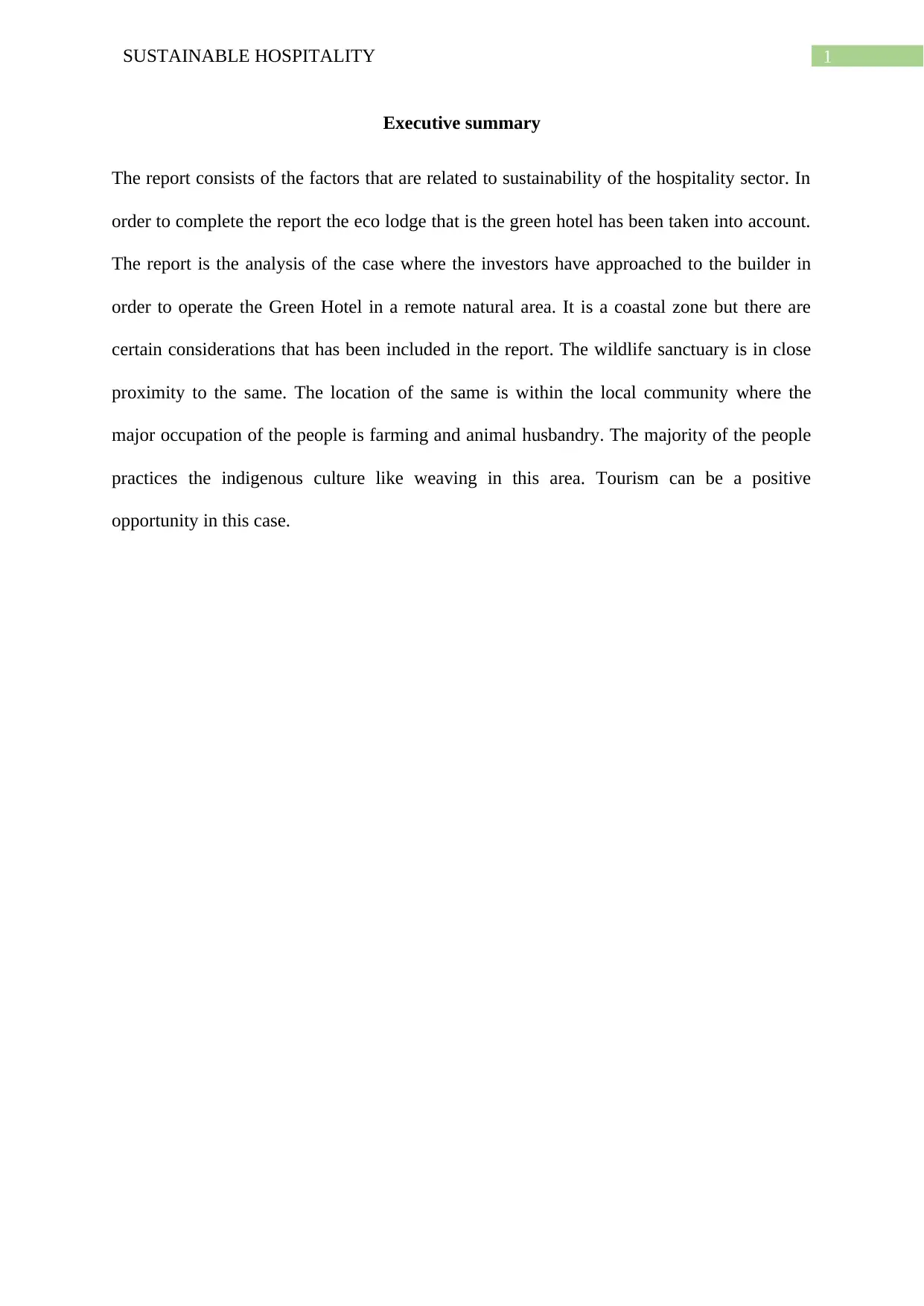
1SUSTAINABLE HOSPITALITY
Executive summary
The report consists of the factors that are related to sustainability of the hospitality sector. In
order to complete the report the eco lodge that is the green hotel has been taken into account.
The report is the analysis of the case where the investors have approached to the builder in
order to operate the Green Hotel in a remote natural area. It is a coastal zone but there are
certain considerations that has been included in the report. The wildlife sanctuary is in close
proximity to the same. The location of the same is within the local community where the
major occupation of the people is farming and animal husbandry. The majority of the people
practices the indigenous culture like weaving in this area. Tourism can be a positive
opportunity in this case.
Executive summary
The report consists of the factors that are related to sustainability of the hospitality sector. In
order to complete the report the eco lodge that is the green hotel has been taken into account.
The report is the analysis of the case where the investors have approached to the builder in
order to operate the Green Hotel in a remote natural area. It is a coastal zone but there are
certain considerations that has been included in the report. The wildlife sanctuary is in close
proximity to the same. The location of the same is within the local community where the
major occupation of the people is farming and animal husbandry. The majority of the people
practices the indigenous culture like weaving in this area. Tourism can be a positive
opportunity in this case.
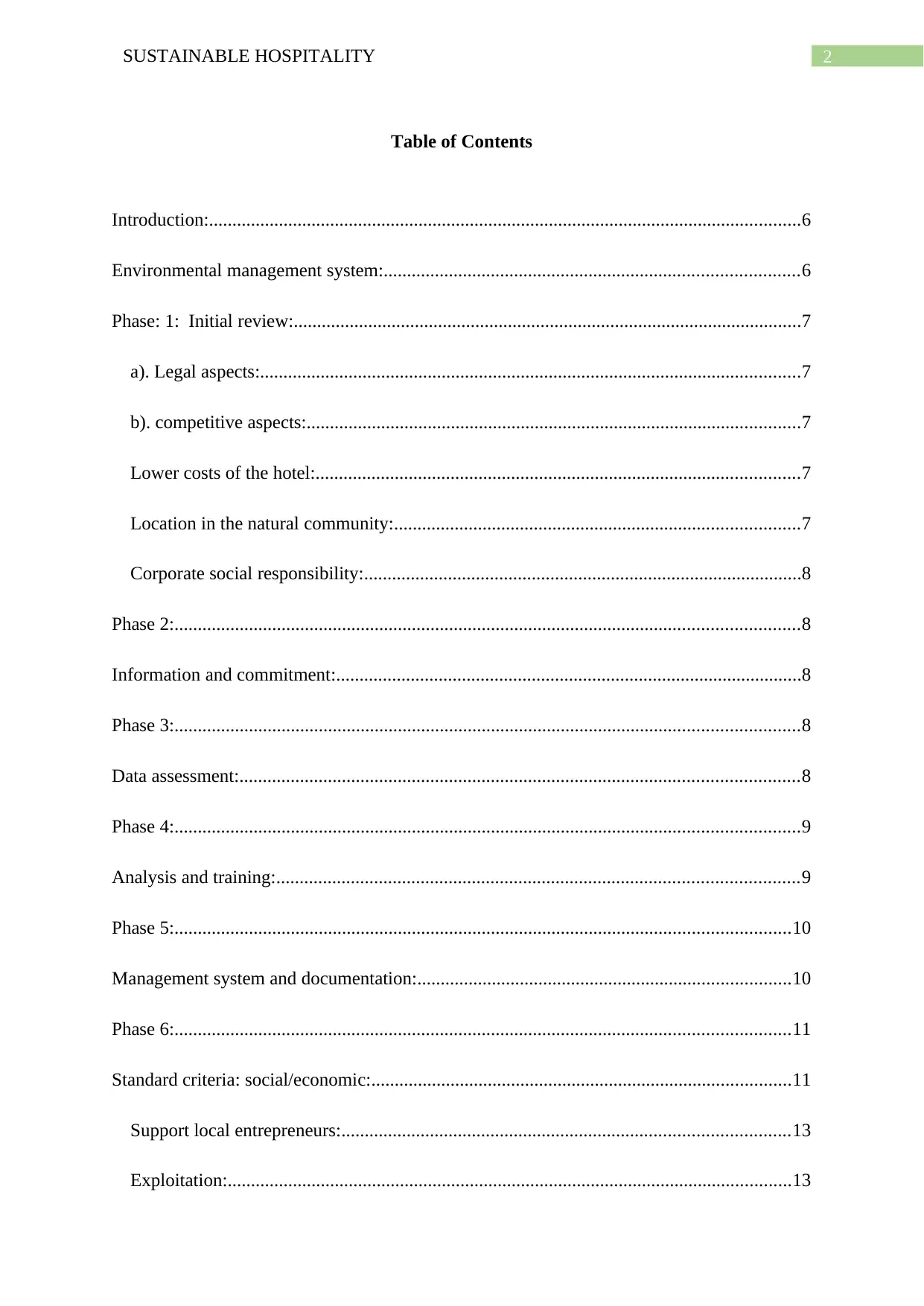
2SUSTAINABLE HOSPITALITY
Table of Contents
Introduction:...............................................................................................................................6
Environmental management system:.........................................................................................6
Phase: 1: Initial review:.............................................................................................................7
a). Legal aspects:....................................................................................................................7
b). competitive aspects:..........................................................................................................7
Lower costs of the hotel:........................................................................................................7
Location in the natural community:.......................................................................................7
Corporate social responsibility:..............................................................................................8
Phase 2:......................................................................................................................................8
Information and commitment:....................................................................................................8
Phase 3:......................................................................................................................................8
Data assessment:........................................................................................................................8
Phase 4:......................................................................................................................................9
Analysis and training:................................................................................................................9
Phase 5:....................................................................................................................................10
Management system and documentation:................................................................................10
Phase 6:....................................................................................................................................11
Standard criteria: social/economic:..........................................................................................11
Support local entrepreneurs:................................................................................................13
Exploitation:.........................................................................................................................13
Table of Contents
Introduction:...............................................................................................................................6
Environmental management system:.........................................................................................6
Phase: 1: Initial review:.............................................................................................................7
a). Legal aspects:....................................................................................................................7
b). competitive aspects:..........................................................................................................7
Lower costs of the hotel:........................................................................................................7
Location in the natural community:.......................................................................................7
Corporate social responsibility:..............................................................................................8
Phase 2:......................................................................................................................................8
Information and commitment:....................................................................................................8
Phase 3:......................................................................................................................................8
Data assessment:........................................................................................................................8
Phase 4:......................................................................................................................................9
Analysis and training:................................................................................................................9
Phase 5:....................................................................................................................................10
Management system and documentation:................................................................................10
Phase 6:....................................................................................................................................11
Standard criteria: social/economic:..........................................................................................11
Support local entrepreneurs:................................................................................................13
Exploitation:.........................................................................................................................13
⊘ This is a preview!⊘
Do you want full access?
Subscribe today to unlock all pages.

Trusted by 1+ million students worldwide
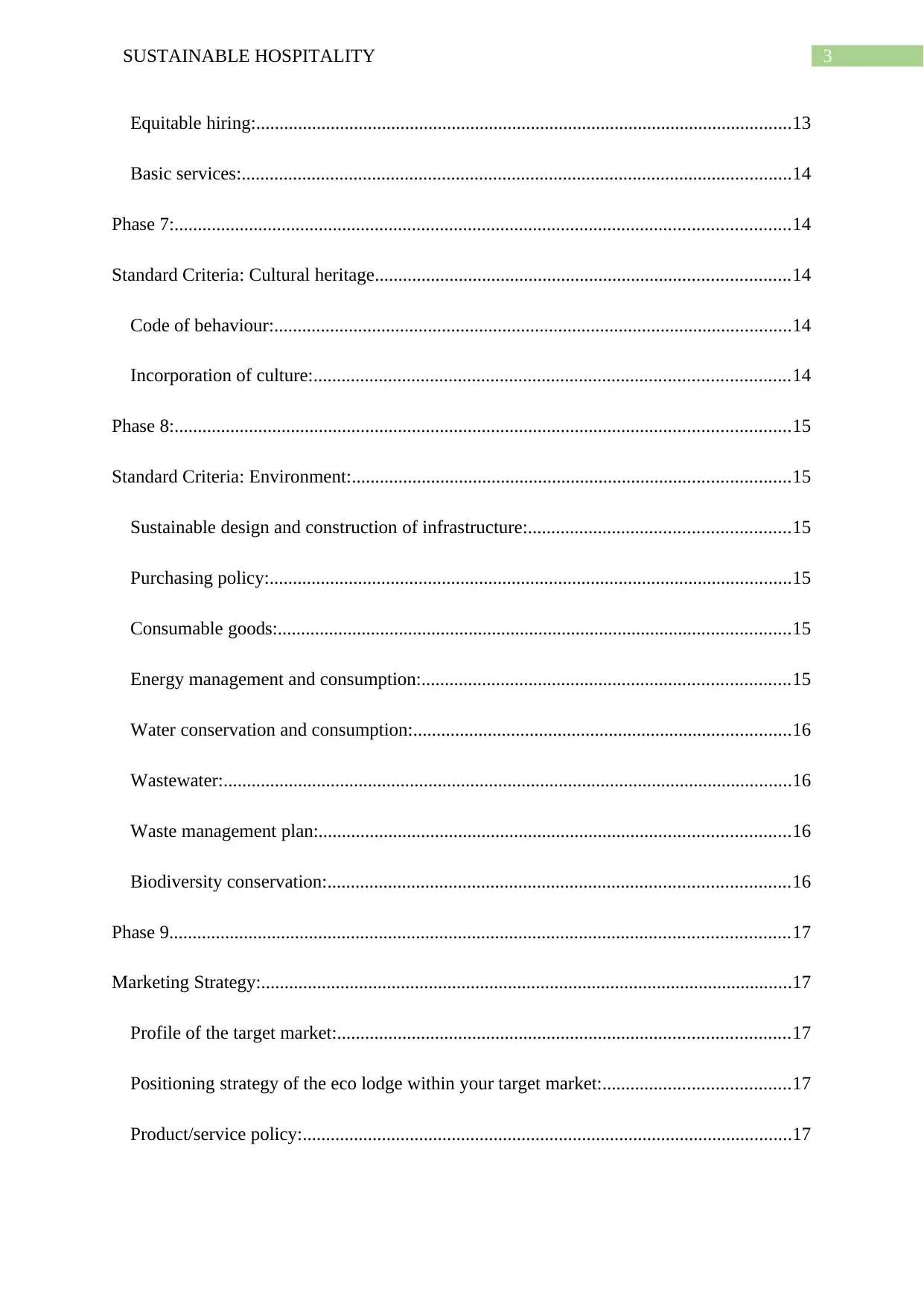
3SUSTAINABLE HOSPITALITY
Equitable hiring:...................................................................................................................13
Basic services:......................................................................................................................14
Phase 7:....................................................................................................................................14
Standard Criteria: Cultural heritage.........................................................................................14
Code of behaviour:...............................................................................................................14
Incorporation of culture:......................................................................................................14
Phase 8:....................................................................................................................................15
Standard Criteria: Environment:..............................................................................................15
Sustainable design and construction of infrastructure:........................................................15
Purchasing policy:................................................................................................................15
Consumable goods:..............................................................................................................15
Energy management and consumption:...............................................................................15
Water conservation and consumption:.................................................................................16
Wastewater:..........................................................................................................................16
Waste management plan:.....................................................................................................16
Biodiversity conservation:...................................................................................................16
Phase 9.....................................................................................................................................17
Marketing Strategy:..................................................................................................................17
Profile of the target market:.................................................................................................17
Positioning strategy of the eco lodge within your target market:........................................17
Product/service policy:.........................................................................................................17
Equitable hiring:...................................................................................................................13
Basic services:......................................................................................................................14
Phase 7:....................................................................................................................................14
Standard Criteria: Cultural heritage.........................................................................................14
Code of behaviour:...............................................................................................................14
Incorporation of culture:......................................................................................................14
Phase 8:....................................................................................................................................15
Standard Criteria: Environment:..............................................................................................15
Sustainable design and construction of infrastructure:........................................................15
Purchasing policy:................................................................................................................15
Consumable goods:..............................................................................................................15
Energy management and consumption:...............................................................................15
Water conservation and consumption:.................................................................................16
Wastewater:..........................................................................................................................16
Waste management plan:.....................................................................................................16
Biodiversity conservation:...................................................................................................16
Phase 9.....................................................................................................................................17
Marketing Strategy:..................................................................................................................17
Profile of the target market:.................................................................................................17
Positioning strategy of the eco lodge within your target market:........................................17
Product/service policy:.........................................................................................................17
Paraphrase This Document
Need a fresh take? Get an instant paraphrase of this document with our AI Paraphraser
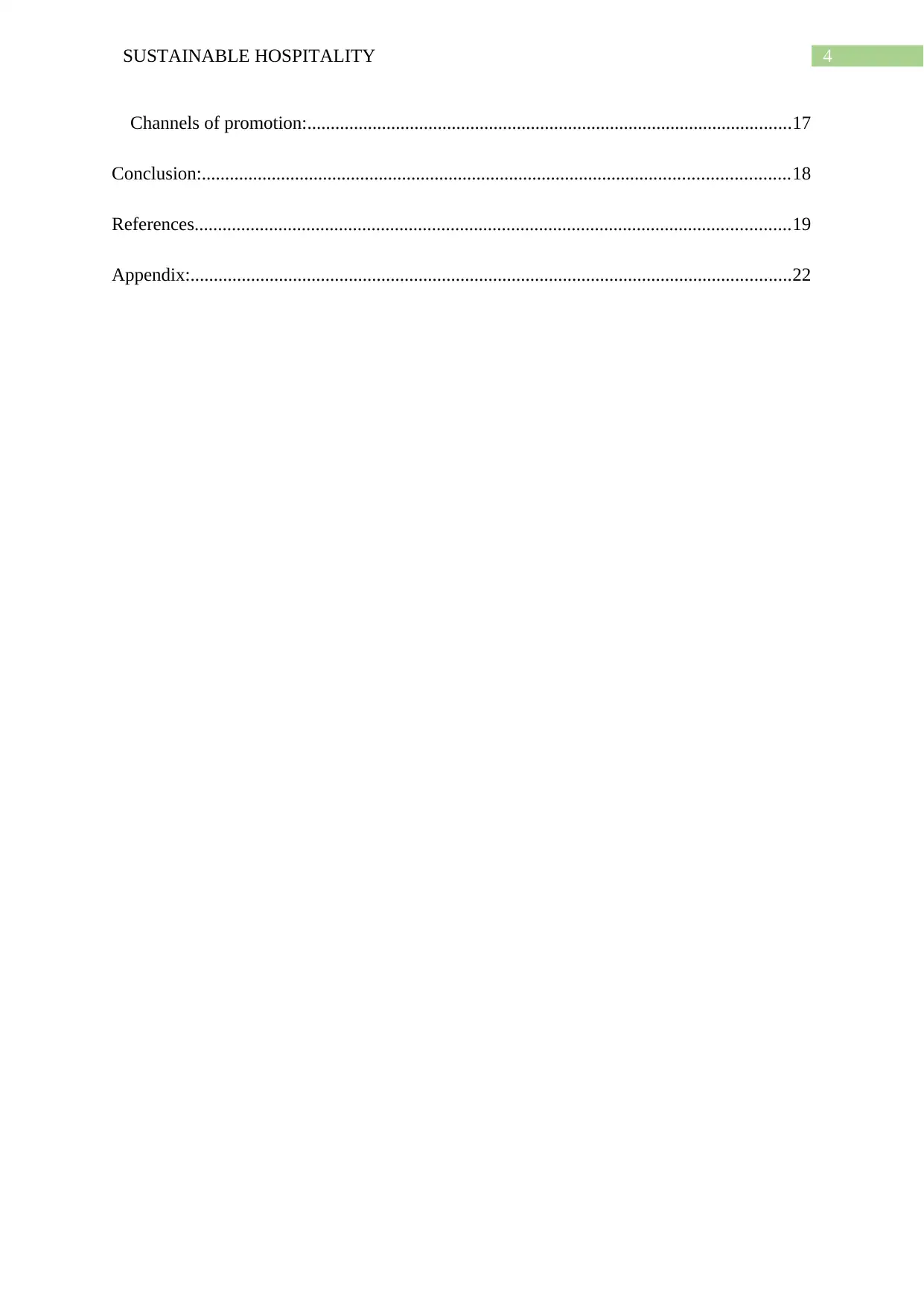
4SUSTAINABLE HOSPITALITY
Channels of promotion:........................................................................................................17
Conclusion:..............................................................................................................................18
References................................................................................................................................19
Appendix:.................................................................................................................................22
Channels of promotion:........................................................................................................17
Conclusion:..............................................................................................................................18
References................................................................................................................................19
Appendix:.................................................................................................................................22
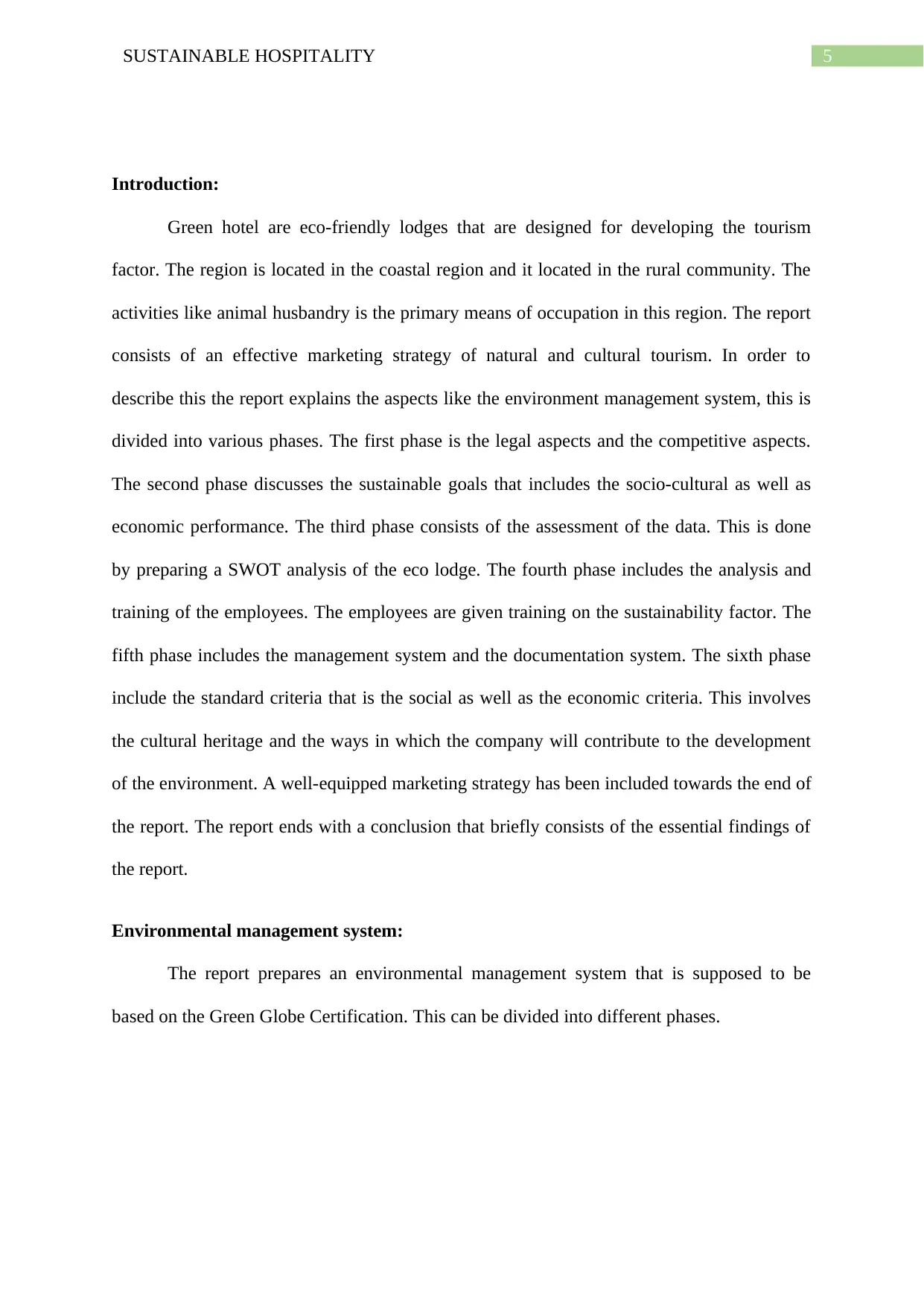
5SUSTAINABLE HOSPITALITY
Introduction:
Green hotel are eco-friendly lodges that are designed for developing the tourism
factor. The region is located in the coastal region and it located in the rural community. The
activities like animal husbandry is the primary means of occupation in this region. The report
consists of an effective marketing strategy of natural and cultural tourism. In order to
describe this the report explains the aspects like the environment management system, this is
divided into various phases. The first phase is the legal aspects and the competitive aspects.
The second phase discusses the sustainable goals that includes the socio-cultural as well as
economic performance. The third phase consists of the assessment of the data. This is done
by preparing a SWOT analysis of the eco lodge. The fourth phase includes the analysis and
training of the employees. The employees are given training on the sustainability factor. The
fifth phase includes the management system and the documentation system. The sixth phase
include the standard criteria that is the social as well as the economic criteria. This involves
the cultural heritage and the ways in which the company will contribute to the development
of the environment. A well-equipped marketing strategy has been included towards the end of
the report. The report ends with a conclusion that briefly consists of the essential findings of
the report.
Environmental management system:
The report prepares an environmental management system that is supposed to be
based on the Green Globe Certification. This can be divided into different phases.
Introduction:
Green hotel are eco-friendly lodges that are designed for developing the tourism
factor. The region is located in the coastal region and it located in the rural community. The
activities like animal husbandry is the primary means of occupation in this region. The report
consists of an effective marketing strategy of natural and cultural tourism. In order to
describe this the report explains the aspects like the environment management system, this is
divided into various phases. The first phase is the legal aspects and the competitive aspects.
The second phase discusses the sustainable goals that includes the socio-cultural as well as
economic performance. The third phase consists of the assessment of the data. This is done
by preparing a SWOT analysis of the eco lodge. The fourth phase includes the analysis and
training of the employees. The employees are given training on the sustainability factor. The
fifth phase includes the management system and the documentation system. The sixth phase
include the standard criteria that is the social as well as the economic criteria. This involves
the cultural heritage and the ways in which the company will contribute to the development
of the environment. A well-equipped marketing strategy has been included towards the end of
the report. The report ends with a conclusion that briefly consists of the essential findings of
the report.
Environmental management system:
The report prepares an environmental management system that is supposed to be
based on the Green Globe Certification. This can be divided into different phases.
⊘ This is a preview!⊘
Do you want full access?
Subscribe today to unlock all pages.

Trusted by 1+ million students worldwide
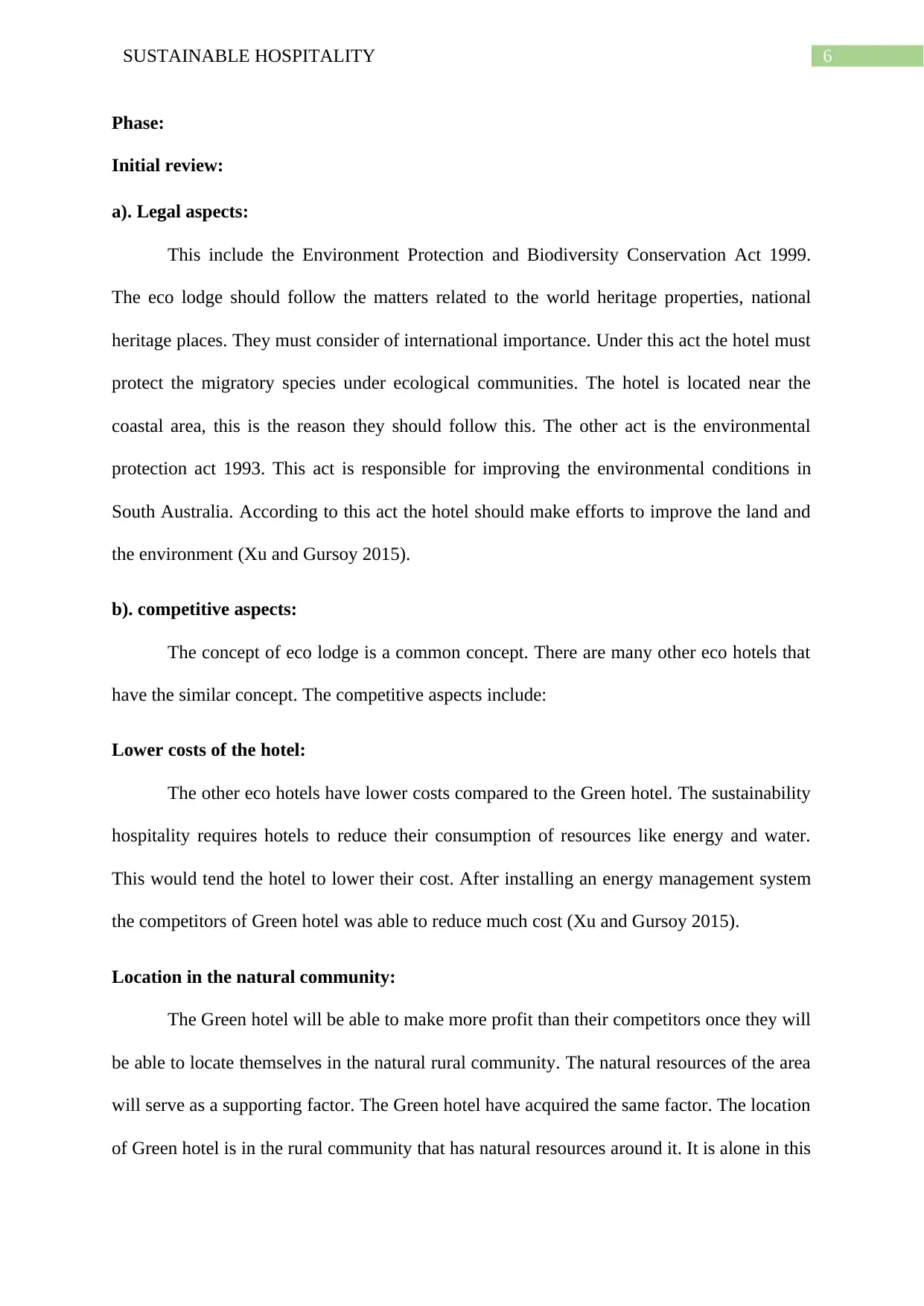
6SUSTAINABLE HOSPITALITY
Phase:
Initial review:
a). Legal aspects:
This include the Environment Protection and Biodiversity Conservation Act 1999.
The eco lodge should follow the matters related to the world heritage properties, national
heritage places. They must consider of international importance. Under this act the hotel must
protect the migratory species under ecological communities. The hotel is located near the
coastal area, this is the reason they should follow this. The other act is the environmental
protection act 1993. This act is responsible for improving the environmental conditions in
South Australia. According to this act the hotel should make efforts to improve the land and
the environment (Xu and Gursoy 2015).
b). competitive aspects:
The concept of eco lodge is a common concept. There are many other eco hotels that
have the similar concept. The competitive aspects include:
Lower costs of the hotel:
The other eco hotels have lower costs compared to the Green hotel. The sustainability
hospitality requires hotels to reduce their consumption of resources like energy and water.
This would tend the hotel to lower their cost. After installing an energy management system
the competitors of Green hotel was able to reduce much cost (Xu and Gursoy 2015).
Location in the natural community:
The Green hotel will be able to make more profit than their competitors once they will
be able to locate themselves in the natural rural community. The natural resources of the area
will serve as a supporting factor. The Green hotel have acquired the same factor. The location
of Green hotel is in the rural community that has natural resources around it. It is alone in this
Phase:
Initial review:
a). Legal aspects:
This include the Environment Protection and Biodiversity Conservation Act 1999.
The eco lodge should follow the matters related to the world heritage properties, national
heritage places. They must consider of international importance. Under this act the hotel must
protect the migratory species under ecological communities. The hotel is located near the
coastal area, this is the reason they should follow this. The other act is the environmental
protection act 1993. This act is responsible for improving the environmental conditions in
South Australia. According to this act the hotel should make efforts to improve the land and
the environment (Xu and Gursoy 2015).
b). competitive aspects:
The concept of eco lodge is a common concept. There are many other eco hotels that
have the similar concept. The competitive aspects include:
Lower costs of the hotel:
The other eco hotels have lower costs compared to the Green hotel. The sustainability
hospitality requires hotels to reduce their consumption of resources like energy and water.
This would tend the hotel to lower their cost. After installing an energy management system
the competitors of Green hotel was able to reduce much cost (Xu and Gursoy 2015).
Location in the natural community:
The Green hotel will be able to make more profit than their competitors once they will
be able to locate themselves in the natural rural community. The natural resources of the area
will serve as a supporting factor. The Green hotel have acquired the same factor. The location
of Green hotel is in the rural community that has natural resources around it. It is alone in this
Paraphrase This Document
Need a fresh take? Get an instant paraphrase of this document with our AI Paraphraser
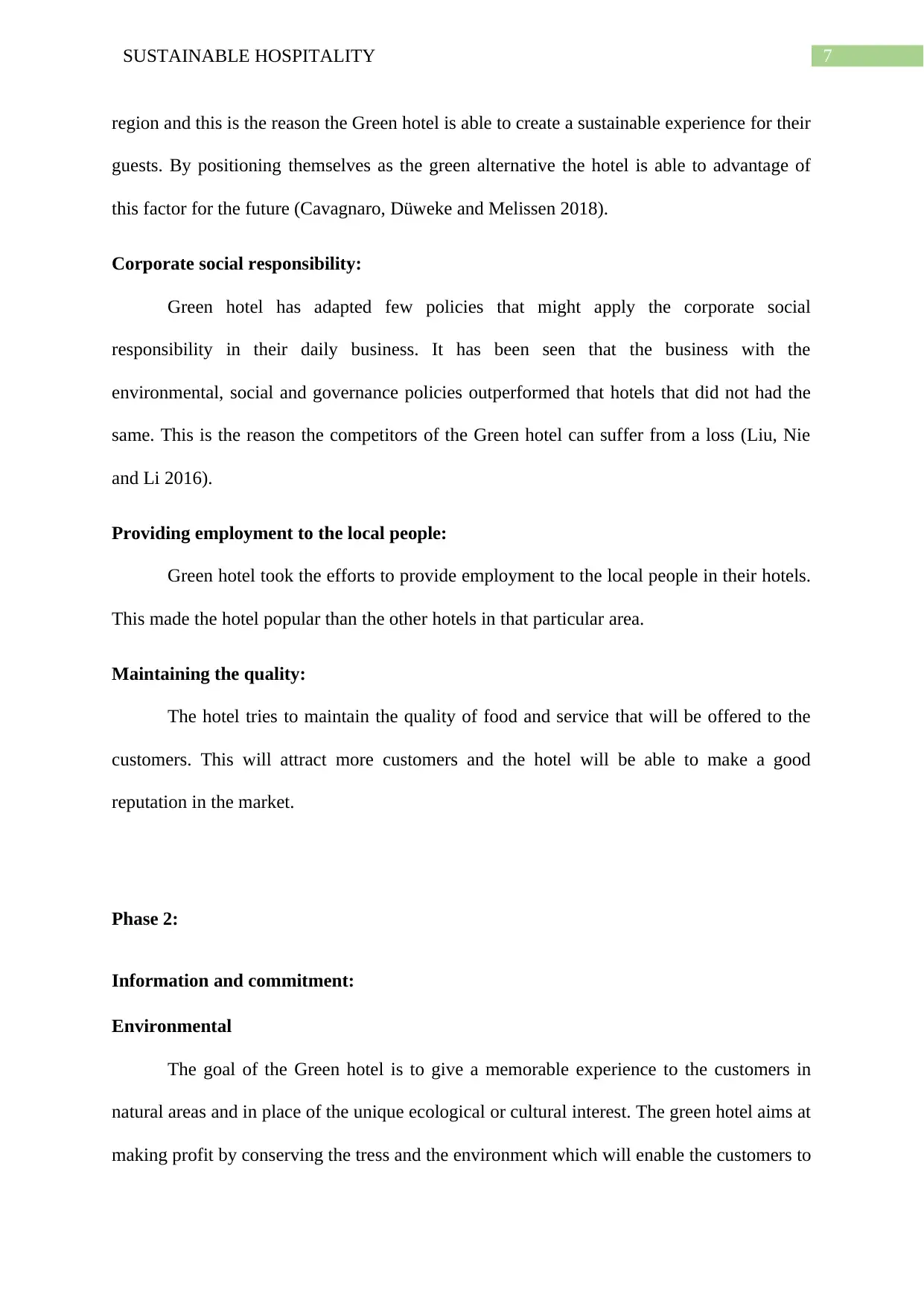
7SUSTAINABLE HOSPITALITY
region and this is the reason the Green hotel is able to create a sustainable experience for their
guests. By positioning themselves as the green alternative the hotel is able to advantage of
this factor for the future (Cavagnaro, Düweke and Melissen 2018).
Corporate social responsibility:
Green hotel has adapted few policies that might apply the corporate social
responsibility in their daily business. It has been seen that the business with the
environmental, social and governance policies outperformed that hotels that did not had the
same. This is the reason the competitors of the Green hotel can suffer from a loss (Liu, Nie
and Li 2016).
Providing employment to the local people:
Green hotel took the efforts to provide employment to the local people in their hotels.
This made the hotel popular than the other hotels in that particular area.
Maintaining the quality:
The hotel tries to maintain the quality of food and service that will be offered to the
customers. This will attract more customers and the hotel will be able to make a good
reputation in the market.
Phase 2:
Information and commitment:
Environmental
The goal of the Green hotel is to give a memorable experience to the customers in
natural areas and in place of the unique ecological or cultural interest. The green hotel aims at
making profit by conserving the tress and the environment which will enable the customers to
region and this is the reason the Green hotel is able to create a sustainable experience for their
guests. By positioning themselves as the green alternative the hotel is able to advantage of
this factor for the future (Cavagnaro, Düweke and Melissen 2018).
Corporate social responsibility:
Green hotel has adapted few policies that might apply the corporate social
responsibility in their daily business. It has been seen that the business with the
environmental, social and governance policies outperformed that hotels that did not had the
same. This is the reason the competitors of the Green hotel can suffer from a loss (Liu, Nie
and Li 2016).
Providing employment to the local people:
Green hotel took the efforts to provide employment to the local people in their hotels.
This made the hotel popular than the other hotels in that particular area.
Maintaining the quality:
The hotel tries to maintain the quality of food and service that will be offered to the
customers. This will attract more customers and the hotel will be able to make a good
reputation in the market.
Phase 2:
Information and commitment:
Environmental
The goal of the Green hotel is to give a memorable experience to the customers in
natural areas and in place of the unique ecological or cultural interest. The green hotel aims at
making profit by conserving the tress and the environment which will enable the customers to
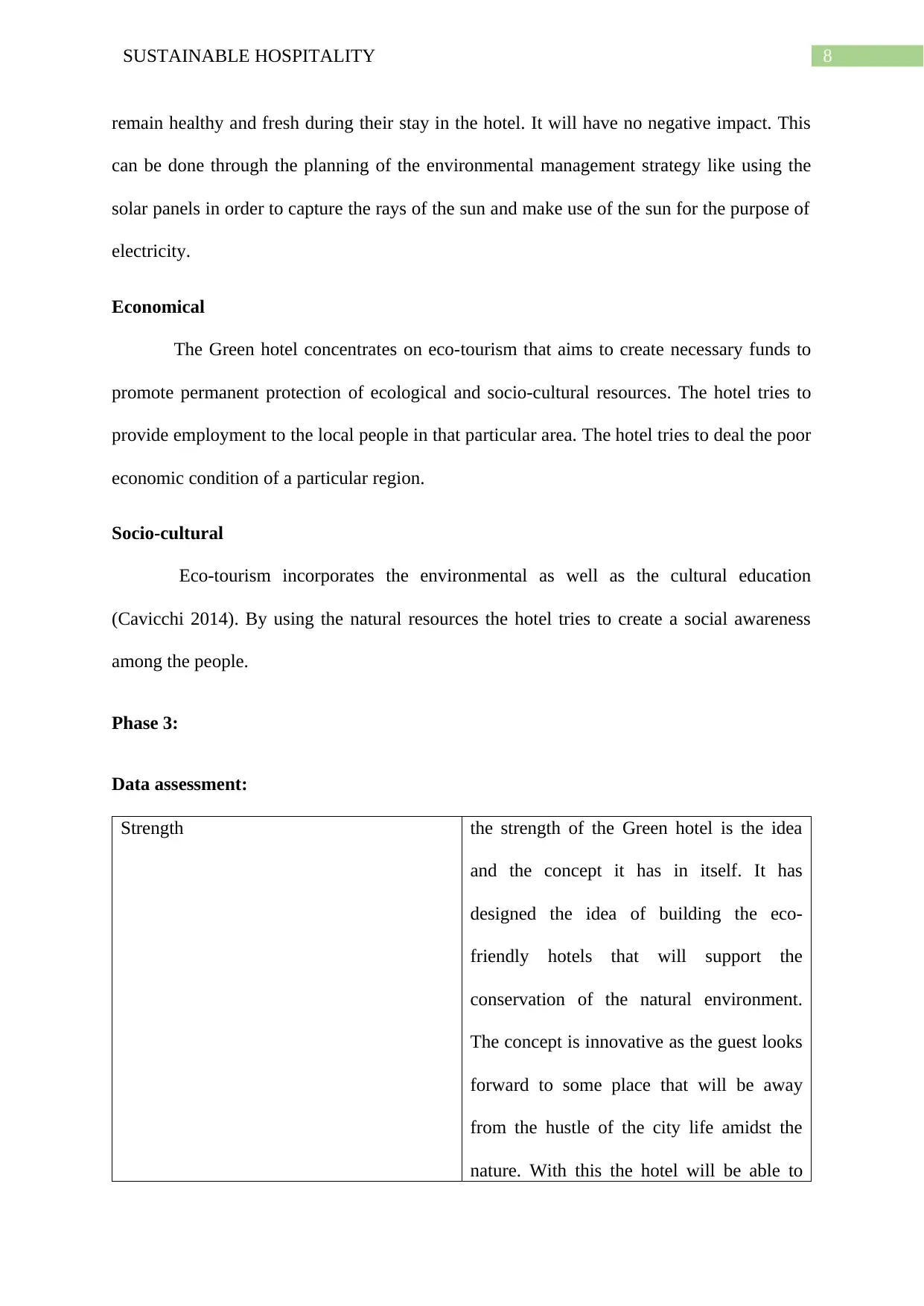
8SUSTAINABLE HOSPITALITY
remain healthy and fresh during their stay in the hotel. It will have no negative impact. This
can be done through the planning of the environmental management strategy like using the
solar panels in order to capture the rays of the sun and make use of the sun for the purpose of
electricity.
Economical
The Green hotel concentrates on eco-tourism that aims to create necessary funds to
promote permanent protection of ecological and socio-cultural resources. The hotel tries to
provide employment to the local people in that particular area. The hotel tries to deal the poor
economic condition of a particular region.
Socio-cultural
Eco-tourism incorporates the environmental as well as the cultural education
(Cavicchi 2014). By using the natural resources the hotel tries to create a social awareness
among the people.
Phase 3:
Data assessment:
Strength the strength of the Green hotel is the idea
and the concept it has in itself. It has
designed the idea of building the eco-
friendly hotels that will support the
conservation of the natural environment.
The concept is innovative as the guest looks
forward to some place that will be away
from the hustle of the city life amidst the
nature. With this the hotel will be able to
remain healthy and fresh during their stay in the hotel. It will have no negative impact. This
can be done through the planning of the environmental management strategy like using the
solar panels in order to capture the rays of the sun and make use of the sun for the purpose of
electricity.
Economical
The Green hotel concentrates on eco-tourism that aims to create necessary funds to
promote permanent protection of ecological and socio-cultural resources. The hotel tries to
provide employment to the local people in that particular area. The hotel tries to deal the poor
economic condition of a particular region.
Socio-cultural
Eco-tourism incorporates the environmental as well as the cultural education
(Cavicchi 2014). By using the natural resources the hotel tries to create a social awareness
among the people.
Phase 3:
Data assessment:
Strength the strength of the Green hotel is the idea
and the concept it has in itself. It has
designed the idea of building the eco-
friendly hotels that will support the
conservation of the natural environment.
The concept is innovative as the guest looks
forward to some place that will be away
from the hustle of the city life amidst the
nature. With this the hotel will be able to
⊘ This is a preview!⊘
Do you want full access?
Subscribe today to unlock all pages.

Trusted by 1+ million students worldwide
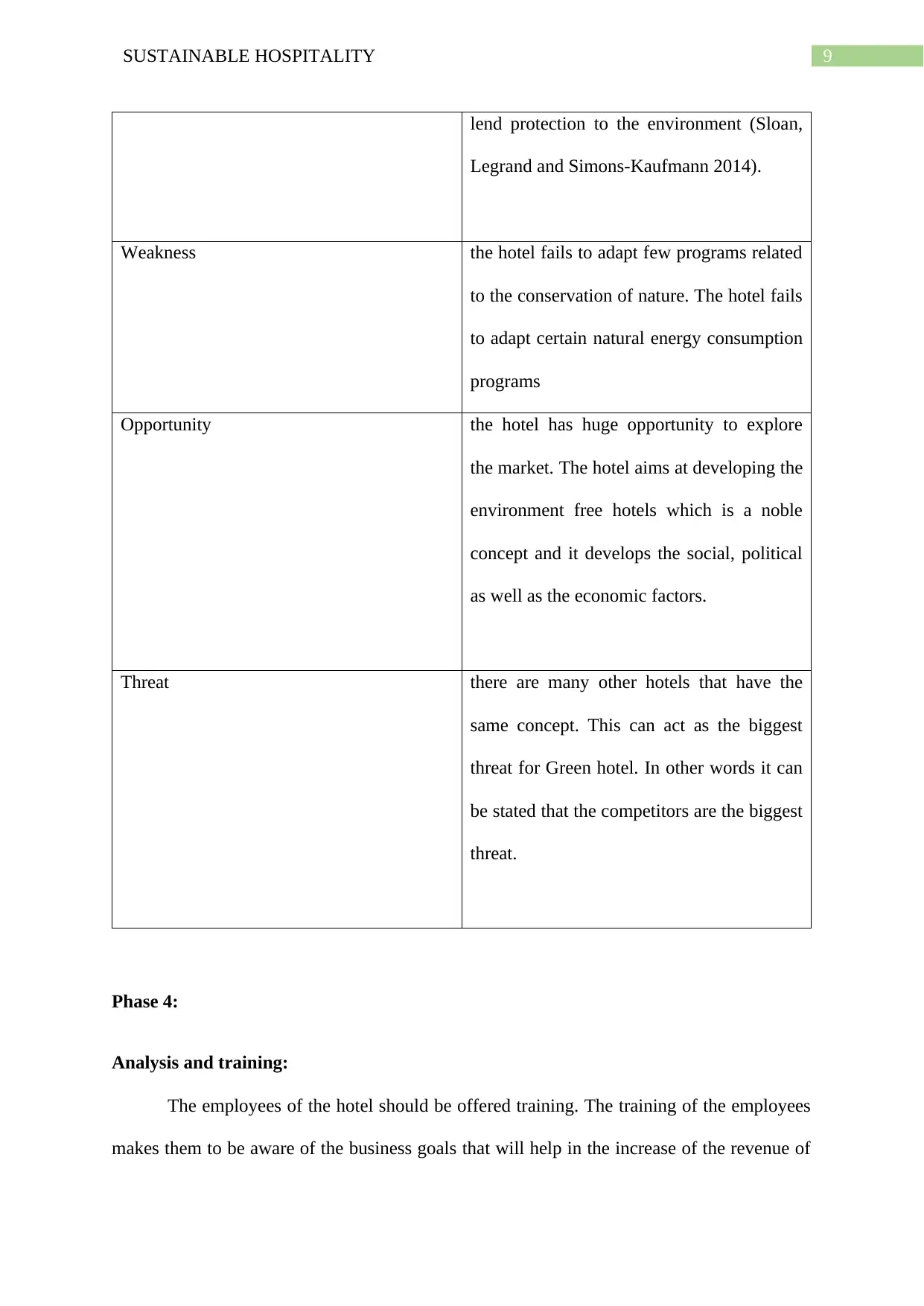
9SUSTAINABLE HOSPITALITY
lend protection to the environment (Sloan,
Legrand and Simons-Kaufmann 2014).
Weakness the hotel fails to adapt few programs related
to the conservation of nature. The hotel fails
to adapt certain natural energy consumption
programs
Opportunity the hotel has huge opportunity to explore
the market. The hotel aims at developing the
environment free hotels which is a noble
concept and it develops the social, political
as well as the economic factors.
Threat there are many other hotels that have the
same concept. This can act as the biggest
threat for Green hotel. In other words it can
be stated that the competitors are the biggest
threat.
Phase 4:
Analysis and training:
The employees of the hotel should be offered training. The training of the employees
makes them to be aware of the business goals that will help in the increase of the revenue of
lend protection to the environment (Sloan,
Legrand and Simons-Kaufmann 2014).
Weakness the hotel fails to adapt few programs related
to the conservation of nature. The hotel fails
to adapt certain natural energy consumption
programs
Opportunity the hotel has huge opportunity to explore
the market. The hotel aims at developing the
environment free hotels which is a noble
concept and it develops the social, political
as well as the economic factors.
Threat there are many other hotels that have the
same concept. This can act as the biggest
threat for Green hotel. In other words it can
be stated that the competitors are the biggest
threat.
Phase 4:
Analysis and training:
The employees of the hotel should be offered training. The training of the employees
makes them to be aware of the business goals that will help in the increase of the revenue of
Paraphrase This Document
Need a fresh take? Get an instant paraphrase of this document with our AI Paraphraser
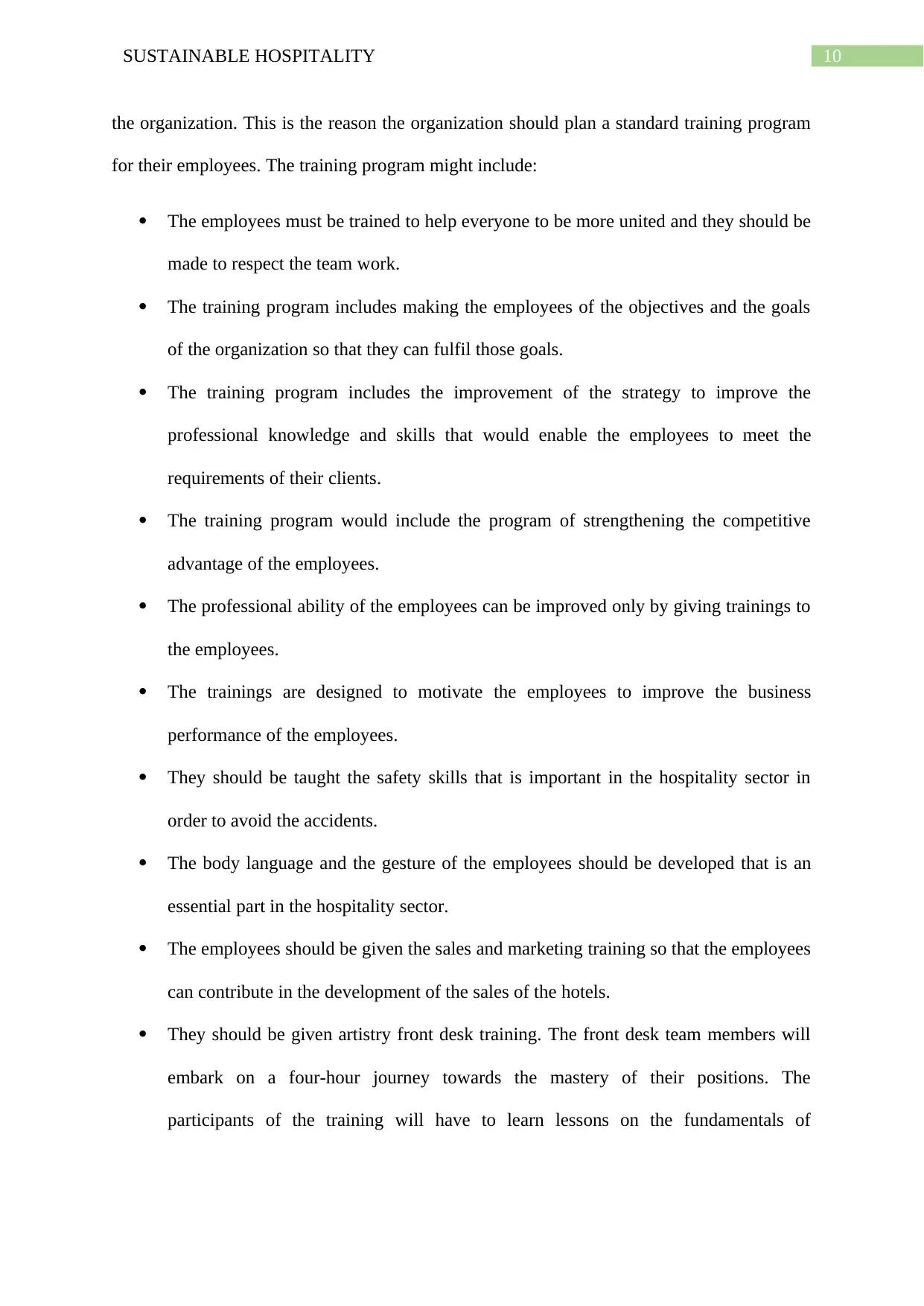
10SUSTAINABLE HOSPITALITY
the organization. This is the reason the organization should plan a standard training program
for their employees. The training program might include:
The employees must be trained to help everyone to be more united and they should be
made to respect the team work.
The training program includes making the employees of the objectives and the goals
of the organization so that they can fulfil those goals.
The training program includes the improvement of the strategy to improve the
professional knowledge and skills that would enable the employees to meet the
requirements of their clients.
The training program would include the program of strengthening the competitive
advantage of the employees.
The professional ability of the employees can be improved only by giving trainings to
the employees.
The trainings are designed to motivate the employees to improve the business
performance of the employees.
They should be taught the safety skills that is important in the hospitality sector in
order to avoid the accidents.
The body language and the gesture of the employees should be developed that is an
essential part in the hospitality sector.
The employees should be given the sales and marketing training so that the employees
can contribute in the development of the sales of the hotels.
They should be given artistry front desk training. The front desk team members will
embark on a four-hour journey towards the mastery of their positions. The
participants of the training will have to learn lessons on the fundamentals of
the organization. This is the reason the organization should plan a standard training program
for their employees. The training program might include:
The employees must be trained to help everyone to be more united and they should be
made to respect the team work.
The training program includes making the employees of the objectives and the goals
of the organization so that they can fulfil those goals.
The training program includes the improvement of the strategy to improve the
professional knowledge and skills that would enable the employees to meet the
requirements of their clients.
The training program would include the program of strengthening the competitive
advantage of the employees.
The professional ability of the employees can be improved only by giving trainings to
the employees.
The trainings are designed to motivate the employees to improve the business
performance of the employees.
They should be taught the safety skills that is important in the hospitality sector in
order to avoid the accidents.
The body language and the gesture of the employees should be developed that is an
essential part in the hospitality sector.
The employees should be given the sales and marketing training so that the employees
can contribute in the development of the sales of the hotels.
They should be given artistry front desk training. The front desk team members will
embark on a four-hour journey towards the mastery of their positions. The
participants of the training will have to learn lessons on the fundamentals of
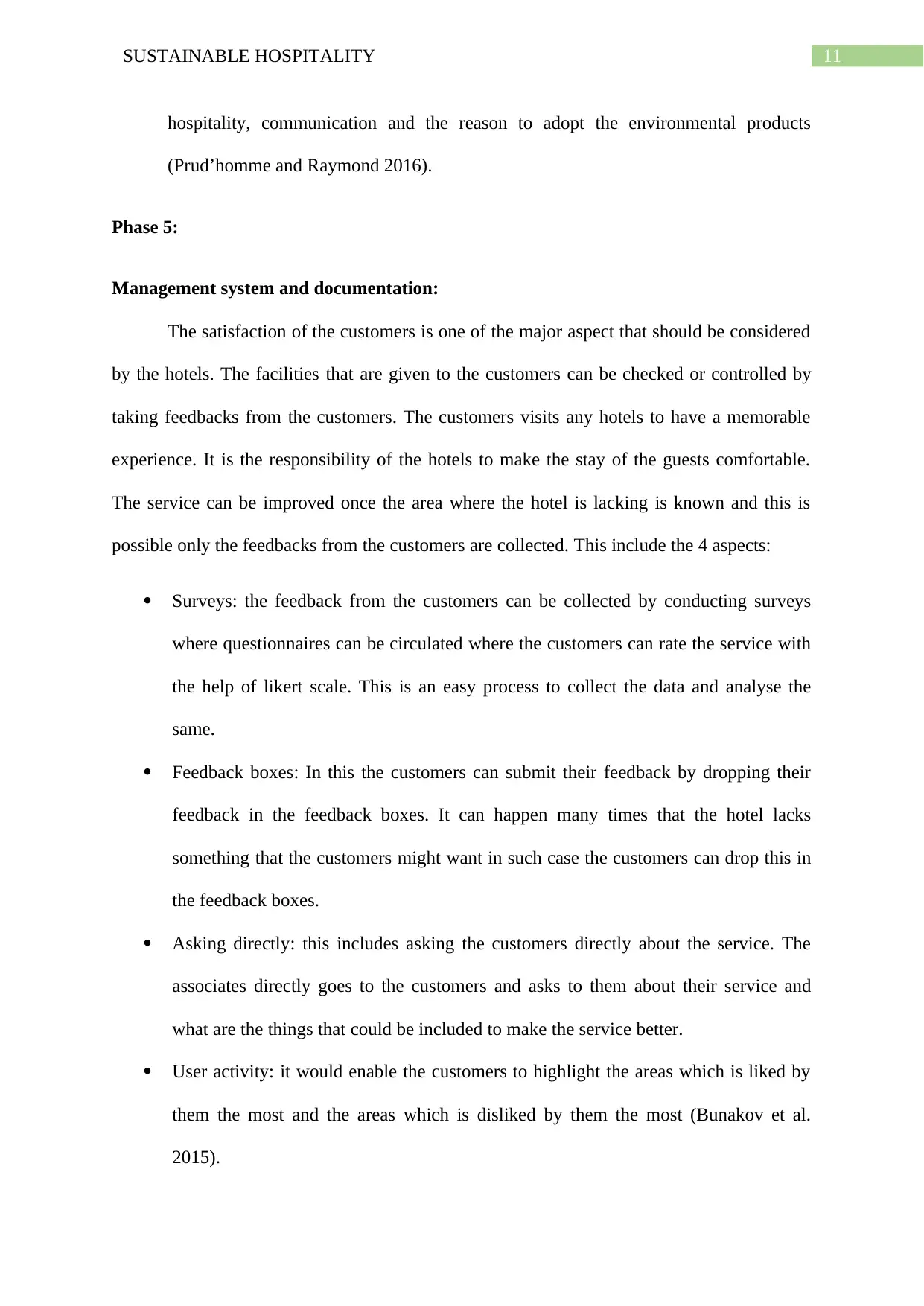
11SUSTAINABLE HOSPITALITY
hospitality, communication and the reason to adopt the environmental products
(Prud’homme and Raymond 2016).
Phase 5:
Management system and documentation:
The satisfaction of the customers is one of the major aspect that should be considered
by the hotels. The facilities that are given to the customers can be checked or controlled by
taking feedbacks from the customers. The customers visits any hotels to have a memorable
experience. It is the responsibility of the hotels to make the stay of the guests comfortable.
The service can be improved once the area where the hotel is lacking is known and this is
possible only the feedbacks from the customers are collected. This include the 4 aspects:
Surveys: the feedback from the customers can be collected by conducting surveys
where questionnaires can be circulated where the customers can rate the service with
the help of likert scale. This is an easy process to collect the data and analyse the
same.
Feedback boxes: In this the customers can submit their feedback by dropping their
feedback in the feedback boxes. It can happen many times that the hotel lacks
something that the customers might want in such case the customers can drop this in
the feedback boxes.
Asking directly: this includes asking the customers directly about the service. The
associates directly goes to the customers and asks to them about their service and
what are the things that could be included to make the service better.
User activity: it would enable the customers to highlight the areas which is liked by
them the most and the areas which is disliked by them the most (Bunakov et al.
2015).
hospitality, communication and the reason to adopt the environmental products
(Prud’homme and Raymond 2016).
Phase 5:
Management system and documentation:
The satisfaction of the customers is one of the major aspect that should be considered
by the hotels. The facilities that are given to the customers can be checked or controlled by
taking feedbacks from the customers. The customers visits any hotels to have a memorable
experience. It is the responsibility of the hotels to make the stay of the guests comfortable.
The service can be improved once the area where the hotel is lacking is known and this is
possible only the feedbacks from the customers are collected. This include the 4 aspects:
Surveys: the feedback from the customers can be collected by conducting surveys
where questionnaires can be circulated where the customers can rate the service with
the help of likert scale. This is an easy process to collect the data and analyse the
same.
Feedback boxes: In this the customers can submit their feedback by dropping their
feedback in the feedback boxes. It can happen many times that the hotel lacks
something that the customers might want in such case the customers can drop this in
the feedback boxes.
Asking directly: this includes asking the customers directly about the service. The
associates directly goes to the customers and asks to them about their service and
what are the things that could be included to make the service better.
User activity: it would enable the customers to highlight the areas which is liked by
them the most and the areas which is disliked by them the most (Bunakov et al.
2015).
⊘ This is a preview!⊘
Do you want full access?
Subscribe today to unlock all pages.

Trusted by 1+ million students worldwide
1 out of 25
Related Documents
Your All-in-One AI-Powered Toolkit for Academic Success.
+13062052269
info@desklib.com
Available 24*7 on WhatsApp / Email
![[object Object]](/_next/static/media/star-bottom.7253800d.svg)
Unlock your academic potential
Copyright © 2020–2025 A2Z Services. All Rights Reserved. Developed and managed by ZUCOL.





